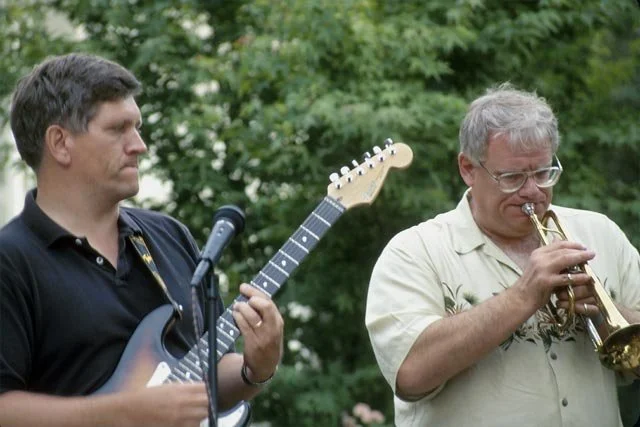Relatively fine arts
Guitarist for the Capertones, a suburban blues band on
Caperton Avenue in Piedmont.
(Yes, that is a C major chord I am straining to form.)
Music
Ballade. I have composed several piano pieces over the years. I showed them to my musically talented lifelong friend Hugh McDevitt, and he picked one and said, “Let me fiddle around with this.” The improbable result is Hugh’s beautifully performed “world premiere” (! his term, not mine) of “Ballade by Rob James” at his San Jose church in 2025. Faster tempo version Sheet music
I hope to publish and perform some of my other compositions, and to write some new ones.
Cadillac Drivin’ Man, performed by the Capertones, a suburban blues band on Caperton Avenue in Piedmont (I played both keyboards and guitar).
Poetry & Performance
Dishabille. I am an enthusiast for old-school poetry—lines that at least scan (I am not as insistent on rhyming, which I find less natural in English than in other languages) inhabiting forms that have a literary heritage. Poetry should invoke the power of words, the magic of sounds, and the weight of traditions—it is not simply obscure emotional or earnest political prose written with jagged right-hand margins. This iambic-pentameter-metered blank verse was published in the Blue Unicorn (vol. 45, no. 1 (2021)).
Haiku. With all due apologies for appropriating an art form—and I recognize I do not use a metaphor from Nature per the classical rules—I wrote and published this 5-7-5 recursive zinger in the Green Bag Almanac, a publication by and for attorneys that emphasizes clarity and brevity, in contrast with so much writing of lawyers:
Legal concision’s
stranger than prolixity—
harder than haiku
Henry James, “The Beast in the Jungle” (audiobook narration on YouTube) A horror story for adults, contemplating the terror of allowing one’s destiny in life to pass him by. Favorite listener comment about my narration: “Dude sounds like Kermit.”
Visual Art
The Tyger. The 1982-83 Yale Law Journal board of editors was selected by the prior board. A striking number of senior editors had undergraduate degrees from Princeton University. Equally striking was the number of prior board senior editors who amazingly also went to that particular college. Though all the choices were excellent and proved successful, the coincidence did produce an unavoidable if unfair inference of nepotism. I was already on a William Blake jag, having been first tipped off to the mystic romantic by Emerson Lake & Palmer’s rendition of Jerusalem, and the idea came to me of writing and illustrating a parody of “The Tyger” based on the Princeton mascot. Read Blake’s original and view his dazzling drawing and calligraphy first, in order to understand what the heck I was adapting.
“Rich” and “Dave” were of course Princetonians on the prior board, “Skelly Wright” was a circuit court judge who regularly fed ambitious clerks to the U.S. Supreme Court, the Law Journal offices were on the “fourth floor” of the school, “Shepardizing” is (along with rejecting manuscripts) a typical law review editor’s task (using Shepard’s books to check the subsequent history of judicial decisions), and “[Ben] Zuraw” was a classmate who (I can say as his lifelong friend without fear of giving offense) exhibited more intensity on the basketball court than in the library. Hence my riff on Blake’s key line asking how God could have created such a ferocious beast—“Did he who made the Lamb make thee?”
Neither Blake’s tyger nor mine looks very scary. My poem and artwork were published in the Yale Law Journal volume 92 banquet issue.
Great Moments in Constitutional Law. In Griswold v. Connecticut, studied widely in law school and vitally relevant today, Justice William O. Douglas struck down a Connecticut statute banning the sale of contraceptives, holding that it violated a federal constitutional right of privacy. He found that principle in the broad “penumbras” (shadows) of various more explicit clauses, including the famous Fourth Amendment prohibiting unreasonable searches and seizures, but also the lesser-known Third Amendment that prohibits the mandated housing of military personnel in residences without the owner’s consent. Dissenting Justice Potter Stewart (he of the “I know it when I see it” test for obscenity) objected to this use of shadows for a ruling on birth control, complaining “No soldier has been quartered in any house.” That struck me as a line worth visualizing in the bedroom. I was a fan of the artwork of B. Kliban, which appeared in Playboy as well as his own books, and imitated his style in this cartoon. It was passed around the law school rather than published, for rather obvious reasons.
